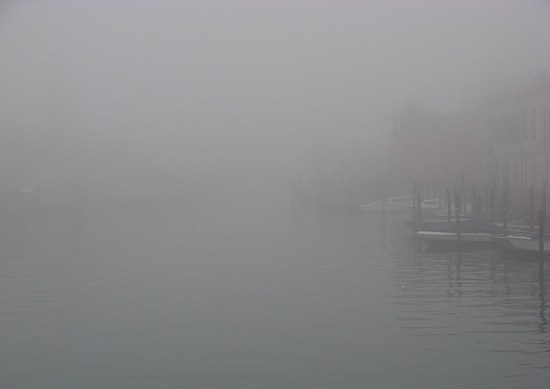We’ve been having fog of various densities and persistence over the past – I’d have to check, it seems like a month or so. Or year. A long time, anyway. And the predictions are for more.
“How romantic,” I hear you thinking. And I agree. Fog can be hauntingly lovely here, all drifting shapes and softening colors and the complete evaporation of the horizon.
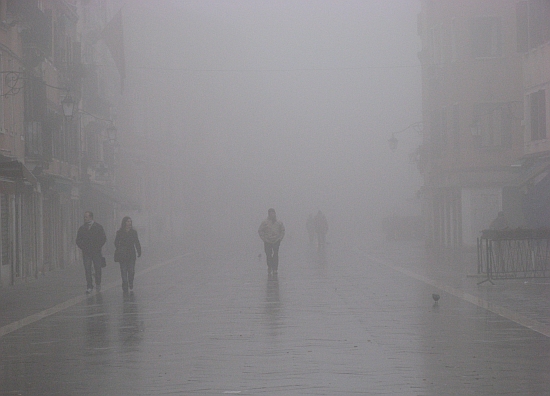
But if you need to move beyond the visual and into the practical, fog can be a pain in the gizzard. Acqua alta may get all the emotional publicity, but I can tell you that acqua from above, in the form of atmospheric condensation, can be just as inconvenient. I suppose nobody makes the same sort of fuss about it because fog doesn’t come into your house. Or shop.
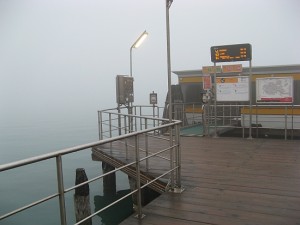
Example: Yesterday morning I was forced to abandon my plan to go to Torcello to meet somebody for an interview (assuming I do, or do not, succeed in re-scheduling said meeting, I will explain who, what and why in another post).
Like many plans — Napoleon’s invasion of Russia, say, or New Coke — it looked perfect on paper. Take the #52 vaporetto at 8:10 to the Fondamente Nove, change to the LN line at 8:40, change to the Torcello line at 9:35, and faster than you can recite the Gettysburg Address, I’d be there. Actually, you’d have to recite it 36 times; door to door requires an hour and a half, but I don’t mind. It’s a beautiful trip, assuming you can see where you’re going.
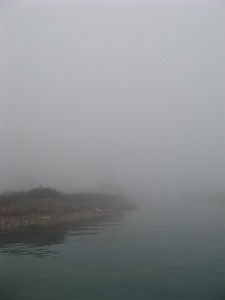
But once again, I discovered — standing there without a Plan B — that the real problem isn’t the fog itself, but the way the ACTV, the transport company, deals with it. The ACTV seems to have wandered beyond a reasonable concern for public safety and into the realm of phobia: “An irrational, intense, and persistent fear of certain situations, activities, things, animals, or people.” I don’t think the ACTV has a fear of animals. Otherwise, fog fits the phobic bill. The solution? According to the dictionary, “The main symptom of this disorder is the excessive and unreasonable desire to avoid the feared stimulus.” In this case, fog.
But the ACTV exists to be outdoors. Much as it might wish the case to be otherwise, it can’t function anywhere else. And more to the point, by now almost all the boats have radar. Yet it seems that the the more radar the company installs, the less willing the company is to trust it.
May I note that there were a good number of people out rowing in the fog yesterday morning, on their way to a boating event at Rialto. I myself have been out rowing in the lagoon with a compass, as has Lino, as have plenty of people. Lino rowed home one time in a fog so thick he couldn’t see the bow of his boat. Just to give you some idea of what is, in fact, feasible.
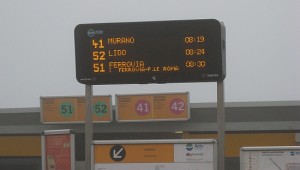
In yesterday’s case, all the vaporettos were, as usual, re-routed up and down the Grand Canal, even those — like the one I wanted — which normally circumnavigate the city’s perimeter. If I’d known in time that the fog was that thick out in the lagoon (as it wasn’t, outside our hovel), I wouldn’t have walked all the way over to the vaporetto stop at San Pietro di Castello. Because once I realized that the boat wasn’t coming, it was too late to activate the most reasonable solution: Walking to the Fondamente Nove to get the boat to Burano. Although there again, even if service were maintained to the outer reaches of the lagoon, it would almost certainly have been on a limited schedule. Like, say, once an hour.
Pause for the sound of the perfect plan drifting out to sea, and the first stifled shriek of the day.

I can’t understand several things. If the boats have radar, why does it not inspire confidence in its operators? And more to the point, if the vaporetto captains can manage to navigate along the shoreline and up the Grand Canal, with or without radar, why could they not, by the same token, circumnavigate the city? The route outside takes them just as close to the shoreline as it does inside — in other words, whichever route they take, they’re not exactly out on the high seas, but within eyeshot of any palaces or pilings or any other landmark that they need to keep track of.
Once again, my sense of logic has run aground in a falling tide on the mudbanks of municipal management.
But one last question: If the city (and by extension, its transport company) is so willing to confront a temporary meteorological situation (fog) with the attitude, “Suck it up, people,” why has it not been willing to confront another temporary meteorological situation (acqua alta) with the same panache?
Answers do suggest themselves, but they are cynical answers, composed of bitter little thoughts about human nature. Best to leave them unexpressed.
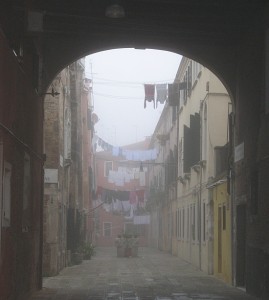
Note to people flying, not floating, yesterday. I’m sorry if your flight was delayed. I realize that flying in fog is stupid and dangerous. But slowly driving a boat in fog, hugging the shoreline, isn’t.
